Thoughts from someone who still can't quite believe that he talks about chess for a living
Tuesday, February 28, 2012
Troubles of a Chess Teacher
Thursday, February 23, 2012
Game of the Weekend
In round four I played against IM Marc Tyler Arnold. He is a 19 year old who already has one GM norm and a FIDE rating over 2500. I expect him to get the GM title sometime this year. I’m not sure how people like to see games, so I’ve included an annotated version here if you want to play out the game with a real chess board, and a PGN version below it where you can click through online. It’s hard to edit in Chessbase, so the text format is probably nicer.
USATE (4), 19.02.2012
[Kane,Jeremy]
Throughout the round it looked like my team was winning the match, but eventually we lost on boards two and three with a draw on board 4. The positive looking match situation affected the course of the game, making me overly eager to draw and Marc overly reluctant. 1.d4 Nf6 2.c4 e6 3.Nc3 Bb4 4.Nf3 b6 Last month I faced c5, which is the other main move. That game is annotated elsewhere on the blog. 5.Bg5 h6 6.Bh4 Bb7 Now I had to think for a bit. I have a book that recommends Nd2 here, but I don't have much experience there, so I transposed to what would have happened if black had played g5 before Bb7 anyway. 7.e3 g5 8.Bg3 d6 In my experience black usually prefers Ne4, so I wanted to check if there was a refutation. I spent 10 minutes trying to decide if Qa4+ wins a piece (it doesn't). Then I continued with normal developing moves. 9.Qc2 Nbd7 10.Bd3 Qe7 11.0–0N Marc said that this was the first new move of the game for him. I was attracted to it because I concerned about allowing black to grab the g2 pawn with g4 and Bxg2. Now my king is somewhat vulnerable, but harder to attack than it may appear. 11...Bxc3 otherwise the bishop will be trapped after Nb5. 12.bxc3 0–0–0 [12...Bxf3 This looks scary for white, but eventually the bishop pair and big center should matter more than the exposed king. 13.gxf3 h5 14.h4 gxh4 15.Bxh4 Rg8+ 16.Kh1 Black can't really get any attackers at the open white king.] 13.e4 Nh5 14.a4 It's useful to push this pawn as part of an attack, but also simply to try to trade off my isolated pawn. 14...a5 15.Nd2 e5 16.Rab1 Nf4 I'm not sure if I really need to eliminate the knight right away, but it seems like a better pieces right now than my bishop. 17.Bxf4 gxf4 18.f3 So far the position is double edged but roughly even. After the game my opponent suggested c5 as a way to completely block up the queenside. As long as a night protects b6 then it's hard to see how white can break through on the queenside. Instead, he came up with the positional plan of Bc6 and Qf6 which would force white to play d5 and block up the position. Fortunately for me, white can strike first. 18...Bc6? [18...Rhg8] 19.c5! At the cost of a pawn I let my bishop and knight use the c4 square and black's king comes under fire. 19...dxc5 20.Ba6+ Bb7 [20...Kb8 21.d5 Ba8 22.Nc4 Ka7 23.Bb5 Nb8 looks horribly passive for black.] 21.Bxb7+ Kxb7 22.d5 Ra8 This is ugly, but needed to defend the a5 pawn. 23.Nc4 Rhg8 He finds a good multi-purpose move to eye the white kind and defend along the 6th rank. 24.Qd3?! [24.Qb3 was suggested by black after the game. The plan is simply to play Qb5 and either capture with the knight on a5 or to bring the queen to c6. I would probably have played this way if I had remotely considered it as a candidate move. 24...Ra6 25.Qb5 Ka7 26.d6 cxd6 27.Rfd1 Rg6 28.Qc6 Nb8 29.Qd5± The two pawn deficit is not nearly as important as all of black's pieces being essentially paralyzed.] 24...Rg6 25.d6 I was overly hasty to cash in on my initiative. This move and the previous one allow black back into the game. [25.Rfd1 continuing to simply improve my position is better.] 25...Qe6 26.Rf2 cxd6 27.Nxb6?! This essentially forces a draw, but white could still have played for more. [27.Rfb2 Ra6 28.Rd1 Kc7 (28...Ra8 29.Nxd6+) 29.Nxe5] 27...Nxb6 28.Rfb2 Kc7 Based on the match situation black tried to keep the game going. [28...Ra6 29.Qxa6+ Kxa6 30.Rxb6+= would have probably been the end of the game if it were not a team event.] 29.Rxb6 Kd7 Black tries to get some winning chances by bringing the king to shelter on the kingside. 30.Rb7+ [30.Qb5+ Ke7 31.Rxd6 Qxd6 32.Qb7+ Qd7 33.Qxa8 Rd6 34.Rb7 Rd1+ would be a draw] 30...Ke8 31.Rb8+ [31.Qd5 I seriously considered offering a queen trade to try to take advantage of my active rooks. Even after some analysis, I'm not sure who's better in this position. Do any of you have thoughts on this?] 31...Rxb8 32.Rxb8+ Ke7 33.Qb5 Kf6 34.Qxa5 Kg5 35.Qd8+ Kh5 36.Qc8 Qa2 Neither side can keep their king safe long enough to make progress, so black offered a draw which I accepted. ½–½
Unfortunately, by this point my result was irrelevant from a team perspective as we scored only .5/3 on the remaining boards. I took a bye in round 5 and then we left for the 5 hour drive back before round 6. Overall I was quite happy with my 3.5/4 performance for the weekend, but with long drawn out games playing down and a missed opportunity playing up, I got a good performance review showing what to work on. For instance in just this game I made three mistakes common among lower rated players:
1. I was overly eager to make a draw when playing up.
2. I was uncomfortable being down material and hence too quick to simplify to a drawn position.
3. Doing post-game analysis with Marc, I could tell that he just saw a lot more than me during the game, including the key move Qb3, that might well have won. Speed and depth of calculation is probably still the main thing separating me from GM strength players like him.
Oh, well. It was a fun weekend. Now back to work.
Wednesday, February 22, 2012
Amateur Team East: Rounds 2 and 3
In round two the team ran into trouble quickly on the even number boards, but the heroic effort deep into the knight by Justin Burgess on board three allowed us to tie the match. I played one of my better games of the event. After the opponent misplayed the opening I got this great looking position:
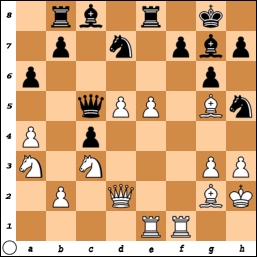
I knew that with the lead in development and so much aimed at the center and kingside, there had to be a breakthrough but it was hard to find. My first instinct was e6, fxe6, dxe6, Ne5 where it seemed that black was getting active. Then I looked at Ne4, which gets nowhere thanks to black’s c3! Finally, I came back to e6, but with an improvement in mind:
e6, fxe6, Rxe6!
Black has no good squares for his e8 rook which was the only defender of the back rank. The game continued:
Rxe6, dxe6, Nxg3!? (Not forced, but there isn’t anything better), Kxg3
and I converted the extra piece without much difficulty.
Round three was by far my worst round of the event. I misplayed the opening against an 1800 and had to struggle (and rely on some mistakes) to enter a very slightly better night endgame. Fortunately, he saved me a long and possibly fruitless endgame grind by blundering a pawn and resigning immediately.
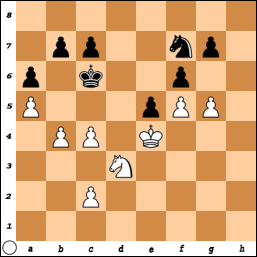
Short on time before reaching move forty, white played g6? and resigned after Nd6+.
I’m still analyzing my fourth and final game from the weekend, against IM Mark Tyler Arnold. I’ll post on that game later this week.
Tuesday, February 21, 2012
Back at the Board
Sorry. I haven’t posted in a few days because I was with my company team at the Amateur Team East Tournament over the long weekend. I had played the North (Previously Titled Midwest) section of this tournament every year since 2004. The Eastern tournament bills itself as the largest tournament in the country each year and the largest team event in the world. This was my first weekend tournament since Amateur Team North last year, although I had played seven games in the DC Chess League (all wins!) in the intervening months.
Here’s a quick recap of round 1, with future rounds to follow.
Round 1: The team was playing down and won convincingly. I had black against a 1900 who was probably in high school. I equalized easily with black, but he forced me to trade a lot of pieces, so I was not sure that I would be able to win from this position:
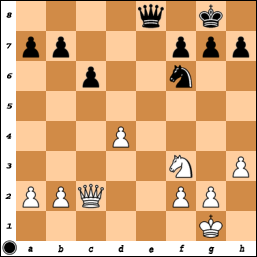
The key imbalance is that white has an isolated pawn on d4, but I think that with accurate play he should be able to hold without too much trouble. Fortunately, I was able to improve my position for the next few moves, while white moved the queen around fairly aimlessly. By the time we reached the following position, things had begun to turn in my favor.
X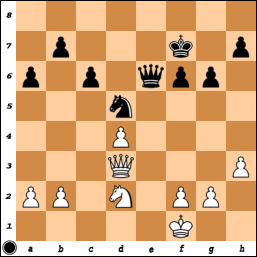
White hasn’t done much in the last few moves, while I’ve managed to improve my knight, queen and king. Here, I played Nb4, which forced Qb3 (I had hoped a bit for Qa3?? Nc2 --- Note: This doesn't actually work because of Qb3, pinning the queen.). I traded queens and marched the king over to snatch the d4 pawn. White defended fairly well down a pawn in the knight ending, but I think it was winning throughout.
I haven’t done a serious analysis of this and my remaining three games yet, but I’ll try to get some up in the next couple days. Here’s the complete first game without annotations. I was happy to win, but a little concerned that a 1900 was able to hold on for 64 moves and 4 1/2 hours.
Tuesday, February 14, 2012
Chess Book Suggestions
Amateur Teams
Wednesday, February 8, 2012
Another Queen's Gambit Trap
Tuesday, February 7, 2012
The Dangerous Queen's Gambit Declined
Sunday, February 5, 2012
Your Blogger in Action
Thursday, February 2, 2012
Alternate Solutions
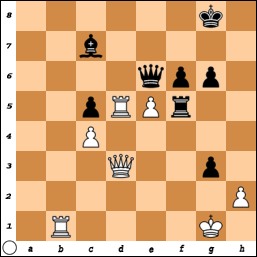
1.Rd8+ Bxd8 2.Qxd8+ Kh7 3.Rb7+ Kh6 4.Qd2+ g5 5.hxg3! (setting a mating net on the h-file)Kg6 6.Qh2 Rf1+ (forced) 7.Kxf1 1-0
It was pretty disappointing when I went to play the first move of this line and the website told me, “Your move is good, but it is not the computer’s first choice. Please try again.”
My pride shot, I eventually found the line that the computer finds marginally better, 1. Rb7 hxg3+ 2. Kh1 Qc6 3. Rxc7 and white will win black’s queen for a rook.